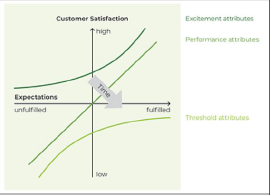Topic_3
Topic 3: Getting Started with UX
UX (User Experience) defined as the overall experience users have with a product or service.
Focus: More than aesthetics; emphasizes usability, enjoyment, and meeting user needs.
3.1 What is UX?
Encompasses all aspects of user interaction with a product:
Usability: Measurement of how easy and efficient the product is to use.
Accessibility: Consideration of how well the product accommodates users with disabilities.
Aesthetics: The visual appeal and overall design of the product.
Engagement: The level of interest and enjoyment during product use.
3.2 Historical Overview of the User Experience Domain
Evolution of UX over the last several decades:
1950s: Birth of Human-Computer Interaction (HCI); visionaries like J.C.R. Licklider sought to enhance user-tech collaboration.
1980s: Rise of personal computers and graphical interfaces, introducing components like menus and mouse usage.
1990s: Expanding web presence necessitated intuitive designs, development of usability testing, and web standards.
2000s: Growth of mobile devices targeted new design principles focusing on small screens and touch interactions.
2010s: Emphasis on user-centric design principles supported by data-driven insights; UX established as a critical design discipline.
3.3 The UX Design Process
Iterative and user-focused methodology:
Empathize: Research to understand user needs and motivations.
Define: Articulate the key problem and goals of the design project.
Ideate: Brainstorm multiple creative solutions and possibilities.
Prototype: Create low-fidelity models to refine concepts.
Test: Engage with real users for usability testing to get feedback and improve the design.
4: User Research and Analysis
Essential for grasping user needs and challenges:
User Interviews: Conduct one-on-one sessions for qualitative feedback.
Usability Testing: Observe how users interact with the product to highlight usability challenges.
Surveys: Use questionnaires for quantitative insights from larger user groups.
5: Information Architecture and Interaction Design
Essential for navigation and interaction:
Sitemaps: Visual layouts of content structure.
Wireframes: Basic sketches of layout and info flow.
Prototypes: Interactive demos for testing design choices.
User Flows: Diagrams illustrating user tasks within the product.
6: Visual Design and Prototyping
Components of visual appeal and mockup development:
Visual Aesthetics: Design elements like typography, color palettes, and images.
Interactive Prototypes: Mockups that simulate the product experience for testing.
7: Usability Testing and Iteration
Critical feedback stage in the design process:
Qualitative Data: Insights from user observations and feedback.
Quantitative Data: Metrics such as task completion times and user satisfaction rates.
8: Common Terms in UX
A/B Testing: Method to compare two design versions and identify the more effective one, varying only one element for accuracy.
Beta Testing: Launching an unfinished product to a select user group to gather real-world performance feedback.
Card Sorting: Technique to assess how users categorize information.
Eye Tracking: Method for tracking visual attention on a website to discern design effectiveness.
Gestalt Principles: Design rules explaining how users perceive grouped elements (e.g., proximity law).
Usability: How effectively users can achieve goals with a product.
Effectiveness: Degree to which goals are met (yes/no metrics).
Efficiency: Assessment of cost vs results, factoring in user efforts.
Satisfaction: Measure of how well a product meets physical, cognitive, and emotional user needs.
9: The KANO Model

Model illustrating customer satisfaction evolution:
Classifies product attributes into:
Threshold (must-be or basic features)
Performance (one-dimensional features)
Excitement (delightful features)
Rejection (reverse attributes)
10: The Tree Metaphor

Crown: User Experience - Differentiation and enthusiasm.
Trunk: Usability - Critical for utility.
Roots: Ergonomics - Essential for preventing long-term issues.